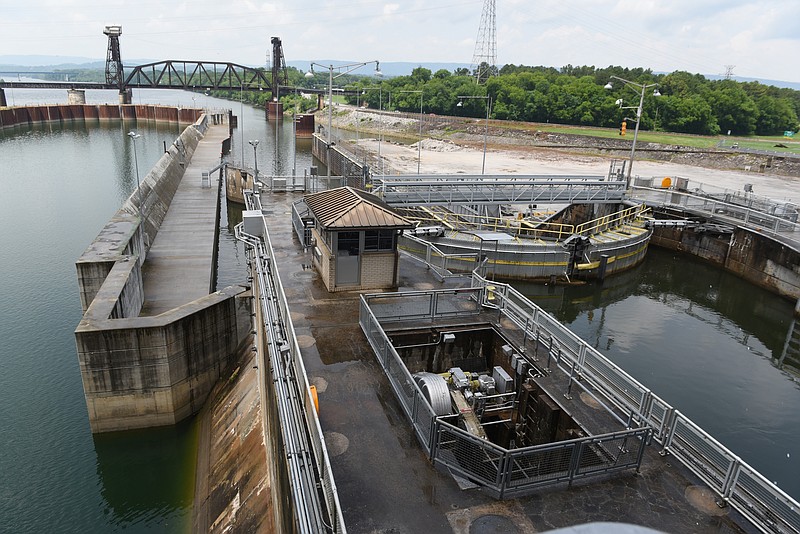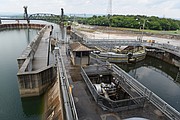Read more
Concrete growth no threat to Chickamauga Dam safety, TVA says
Despite the urging of Tennessee's congressional delegation, the federal agency responsible for building a new lock at the Chickamauga Dam has yet to commit to using $6 million of surplus funds this year to help restart construction of the new lock, which has been stalled by a lack of money for more than three years.
But with an extra $29 million available for the project next year in both the House and Senate appropriation plans moving through Congress, the U.S. Army Corps of Engineers should resume construction of the new and bigger lock in Chattanooga by next spring, at the latest.
Farmers, manufacturers and food processors that rely on the Tennessee River for shipments said Monday that construction can't come too soon on the new and bigger lock. Without a new lock, the current 75-year-old lock in Chattanooga may soon permanently close due to structural problems, effectively cutting off 318 miles of navigable river access upstream of Chattanooga.
"A new lock is critical for us and many others who rely upon the Tennessee River for shipments," said Tom Tirabassi, vice president of supply chain management for Olin Corp. in Charleston, Tenn., which ships more than 200,000 tons a year of its products on the river.
The new lock, which will be 110 feet wide and 600 feet long, will be more than three times the size of the existing lock and will be capable of handling multiple barges at a time.
"That would help tremendously to speed shipments and boost the number of barges we use," said Gerry Schlueter, plant manager for Tate and Lyle in Loudon, Tenn.
Such delays in locking through the older and smaller lock at the Chickamauga Dam have helped reduce the volume of goods shipped through the Chickamauga Lock each year from more than 2.5 million tons at the peak in in 2007 to only 959,290 tons in 2013. Last fall, the existing lock had to shut down unexpectedly to repair problems from the crumbling walls and supports for the lock gates.
"The old lock is falling apart because of concrete growth," Don Getty, the Corps' project manager, told the Waterways Council during a tour of the Chickamauga Lock on Monday.
But the Corps projects that building the new Chickamauga Lock will cost another $677 million and 10 years to complete. The Inland Waterways Trust Fund, which is jointly funded by federal taxpayer monies and fuel taxes paid by barge operators, has only had enough money in the past couple of years to pay for work on the Olmsted Lock and Dam on the Ohio River and the Lower Monongahela River in Pennsylvania.
"I can't wait to see shovels moving again on this project," U.S. Rep. Chuck Fleischmann said. "I went to Congress because I wanted to fix some things which were broken and there's no question in my mind that the Inland Waterway Trust Fund was broken and needed to be fixed if we were going to build this vitally needed new lock."
The path to build such projects was different than in the past when congressional earmarks allowed a member of Congress to designate funds for a particular project. Congress outlawed such earmarks nearly a decade ago and projects like Chickamauga have had to wait behind higher priority, but far costlier projects in Ohio and Pennsylvania.
Last year, Congress freed up more to build locks, dams and ports by allocating more money to finish the $3 billion Olmsted Lock and by raising the fuel tax on barges from 20 cents to 29 cents per gallon.
The new fuel tax, which began in April, is projected to give the Corps at least $6 million more than what it has budgeted in the current fiscal year. But the head of the Corps' civil engineering division, Jo-Ellen Darcy, has yet to commit to using such funds.
"I tried to get the Corps to spend at least $3 million of that at the Chickamauga Lock," said U.S. Sen. Lamar Alexander, the Tennessee Republican who chairs the energy and water subcommittee of the Senate Appropriations Committee. "She (Secretary Darcy) beat around the bush and she never did it. I'm still trying though."
Getty said he also is pushing Corps leadership for at least $3 million to award contracts to resume the lock work. Those contracts could be quickly increased with additional funding in fiscal 2016. Otherwise, work probably won't resume until next March or later, Getty said.
'"Legislatively, we've done what needed to be done and it's up to the Corps," Fleischmann said.
The House and Senate boosted the overall Corps of Engineers budget for fiscal 2016 by $700 million above what Obama budget planners had proposed in the president's initial budget.
"What that does is to provide the Corps enough money to do what it needs to do for priority 1, 2 and 3 (of the inland waterways orojects) and still have $29 million left over to restart the Chickamauga Lock," Alexander said. "Under our rules, I can't tell them to spend the money on Chickamauga. But they know that is why they got the money. I fully expect the Corps in fiscal 2016 to restart Chickamauga Lock."
Prior to the congressional action, the Corps' long-term funding plan said funding for the new Chickamauga Lock might not be available until 2029. Fleischmann, who had signed a pledge not to raise federal taxes and criticized congressional earmarks, agreed last year to boost what he said are user fees paid by barge operators and support a bigger taxpayer share of the new Olmsed lock to help expedite the new Chickamauga Lock.
"You have moved this project forward 13 years - with a tremendous savings and benefit to the taxpayers," Waterways Council President Mike Toohey told Fleischmann.
Contact Dave Flessner at dflessner@timesfreepress.com or at 757-6340.

